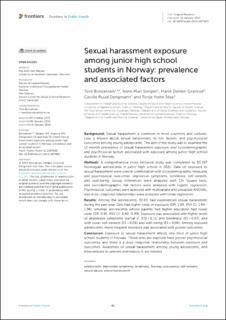| dc.description.abstract | Background: Sexual harassment is common in most countries and cultures. Less is known about sexual harassment, its risk factors, and psychosocial outcomes among young adolescents. The aim of the study was to examine the 12-month prevalence of sexual harassment exposure, and sociodemographic and psychosocial factors associated with exposure among junior high school students in Norway.
Methods: A comprehensive cross-sectional study was completed by 83,297 Norwegian adolescents in junior high school in 2021. Data on exposure to sexual harassment were used in combination with sociodemographic measures and psychosocial outcomes: depressive symptoms, loneliness, self-esteem, and well-being. Group differences were analyzed with Chi Square tests, and sociodemographic risk factors were analyzed with logistic regression. Psychosocial outcomes were assessed with multivariate and univariate ANOVAs, and dose–response relationships were assessed with linear regression.
Results: Among the adolescents, 32.6% had experienced sexual harassment during the past year. Girls had higher odds of exposure (OR: 1.90, 95% CI: 1.84–1.96), whereas adolescents whose parents had higher education had lower odds (OR: 0.95, 95% CI: 0.90–0.99). Exposure was associated with higher levels of depressive symptoms (partial η2 [ES] = 0.11) and loneliness (ES = 0.07), and with lower self-esteem (ES = 0.06) and well-being (ES = 0.06). Among exposed adolescents, more frequent exposure was associated with poorer outcomes.
Conclusion: Exposure to sexual harassment affects one third of junior high school students in Norway. Those who are exposed have poorer psychosocial outcomes, and there is a dose–response relationship between exposure and outcomes. Awareness of sexual harassment among young adolescents, and interventions to prevent and reduce it, are needed. | en_US |

